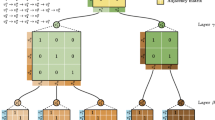Abstract
In a dimensional problem, the transformation of a graph into its linear network can be viewed as a transition involving demand and supply. A connected graph represents the demand flows between the components in the graph while the network supporting it is the resource or capacity links for supporting the demand volumes. The transformation involves a mapping from the graph to its network to satisfy certain performance metrics. In this work, we propose a model for transforming a connected graph to its linear network model in the form of a single-row routing network. The main objective is to provide an optimum routing network that minimizes the congestion. In this technique, the given graph is first partitioned into several disjoint cliques using the Hopfield neural network using our model called AdCliq. From the cliques, a set of intervals derived from the zones are obtained through the matching nodes in the single-row axis. The intervals are then mapped into a network of non-crossing nets using our previously developed tool called ESSR. The network is optimal in terms of minimum street congestion and number of doglegs, and this provides a reasonably good step towards the overall solution to the demand-supply problem.
Similar content being viewed by others
References
So HC (1974) Some theoretical results on the outing of multilayer printed wiring board. In: Proc. IEEE Symp Circuits Syst pp. 296–303
Salleh S, Olariu S, Sanugi B, MIA Aziz, (2005) Single-row transformation of complete graphs. J Supercomput 31(3):265–279
Salleh S, Sanugi B, Jamaluddin H, Olariu S, Zomaya AY (2002) Enhanced simulated annealing technique for the single-row routing problem. J Supercomput 21(3):285–302
Pioro M, Medhi D (2004) Routing, flow and capacity design communication and computer networks. Morgan-Kaufmann.
Kuh ES, Kashiwabara T, Fujisawa T (1979) On optimum single-row routing. IEEE Trans Circuits Syst 26(6):361–368
Deogun JS, Sherwani NA (1988) A decomposition scheme for single-row routing problems. Technical Report Series #68, Dept of Computer Science, Univ. of Nebraska.
Du DH, Liu LH (1987) Heuristic algorithms for single row routing. IEEE Trans Comput 36(3):312–319
Salleh S, Zomaya AY (1999) Scheduling for parallel computer systems: fuzzy and annealing techniques. Kluwer Academic Publishing, Boston.
Hopfield JJ, Tank DW (1985) Neural computation of decisions in optimization problems. Biol Cybern 52:141–152
Galán-Marín G, Muñoz-Pérez J (2001) Design and analysis of maximum Hopfield networks. IEEE Trans Neural Netw 12(2):329–339
Takefuji Y (1992) Neural network parallel computing. Kluwer Academic Publishers, Boston.
Author information
Authors and Affiliations
Rights and permissions
About this article
Cite this article
Salleh, S., Olariu, S., Zomaya, A.Y. et al. Single-row mapping and transformation of connected graphs. J Supercomput 39, 73–89 (2007). https://doi.org/10.1007/s11227-006-0005-4
Issue Date:
DOI: https://doi.org/10.1007/s11227-006-0005-4




